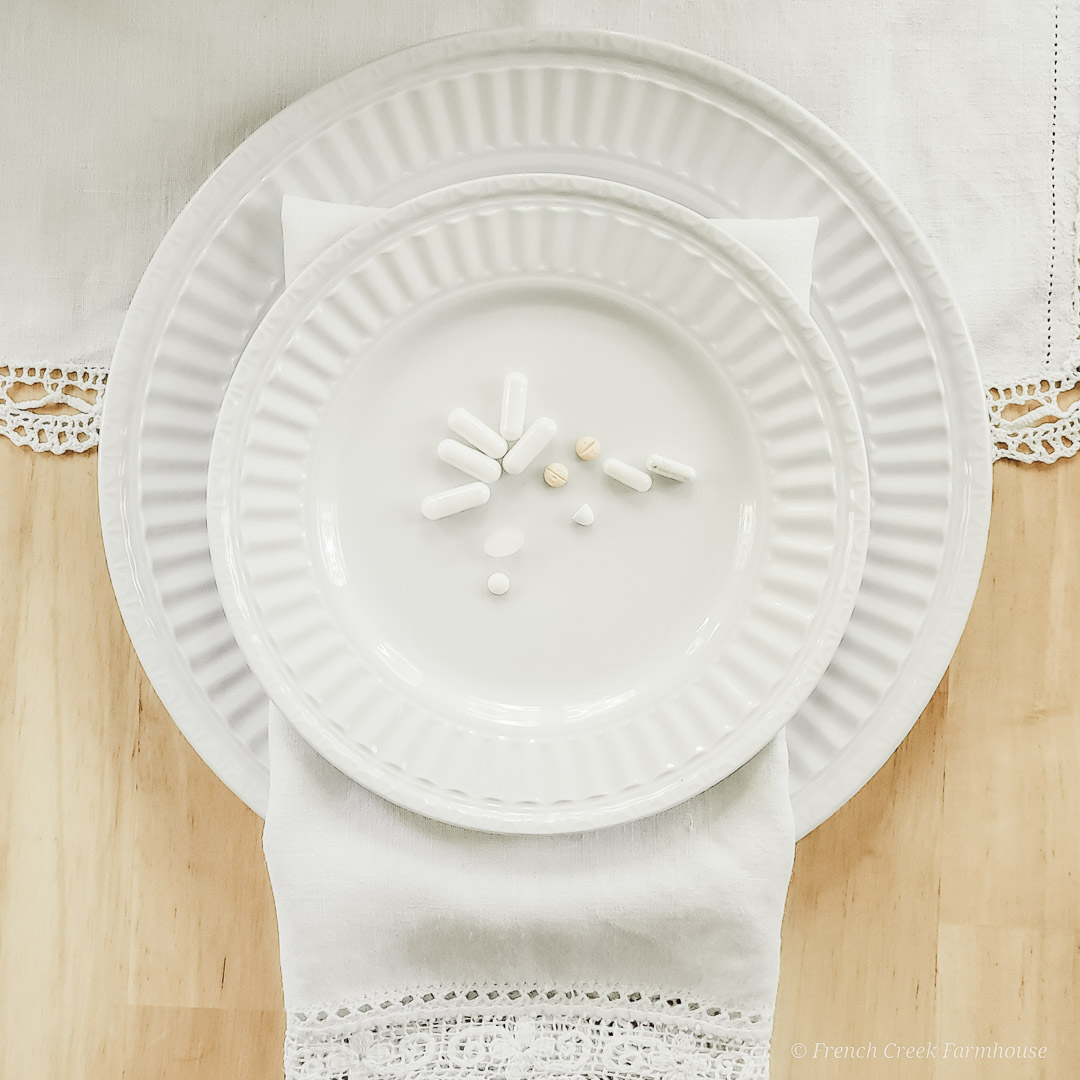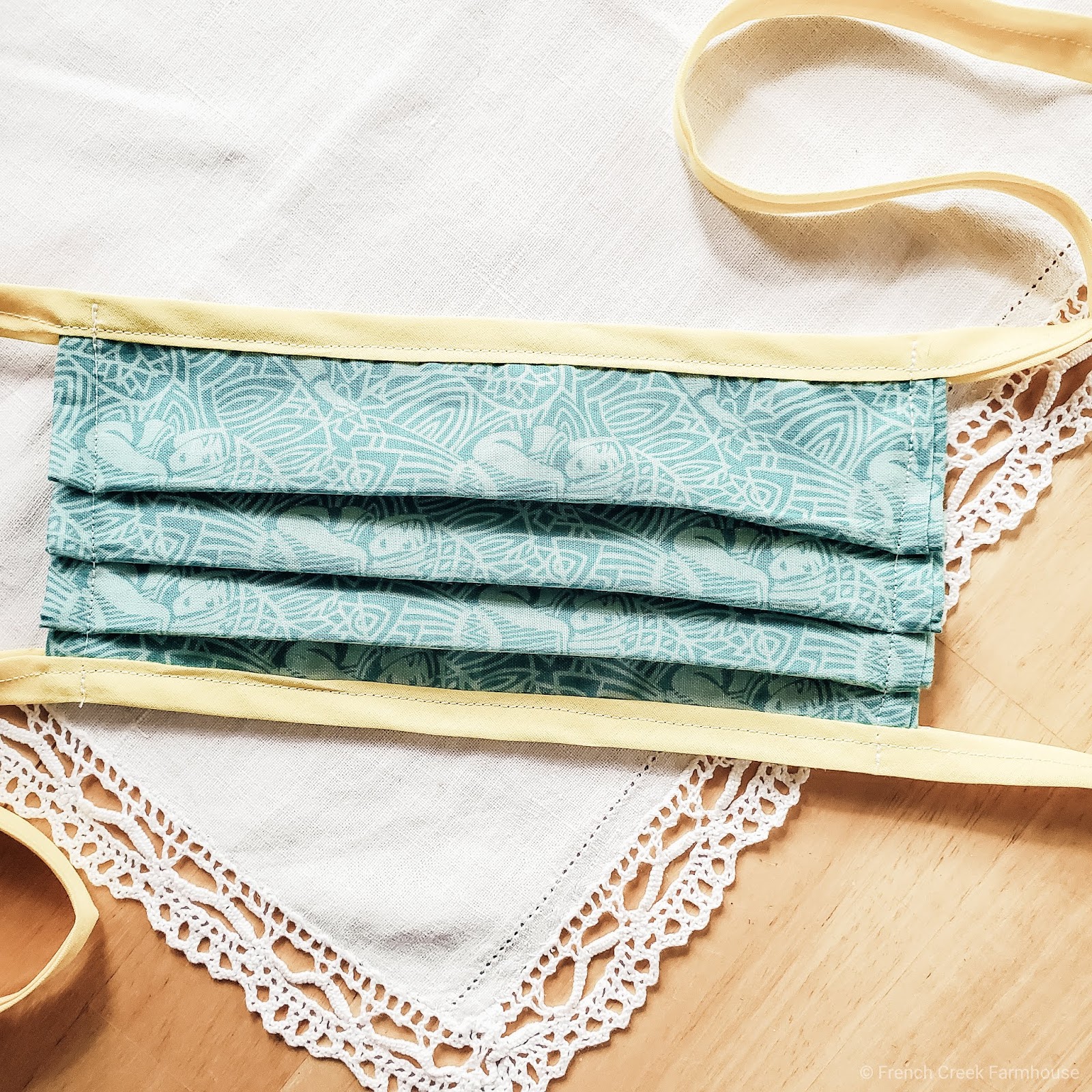Living With Dysautonomia: April 2021 Update – Deciding on Treatment Approaches
This month, I’m digging into the question over using pharmacological versus non-pharmacological treatment approaches, as well as how we’re making
the decision about which treatments we use to manage my dysautonomia.
If you’re a new friend, or you’ve missed some of the previous posts where I’ve shared about what we’ve been going through over the past year, you might be wondering why is this home/DIY blogger talking about her health?
Valid question!
But truly, this blog is an online journal about our life and home. After what we’ve experienced, it has impacted every part of our life, as well as how we manage our home and little farm. We cannot separate the two because living with dysautonomia has become part of our family’s story.
It’s my hope that sharing our experiences as we learn to live with this condition might help someone else. If that happens, then it’s all been worthwhile.
Last month, we shared the first ever update, and the response was overwhelming. So many people are living with chronic health issues, and we even heard from a few people who are struggling with dysautonomia as well.
After such a positive response, I’ve decided to continue to share monthly updates. At least, for a little while. Again, if if can help someone else–I’m in!
In an effort not to repeat the story of how we got here, I’ll provide links back to previous posts. My goal with each new post is to try to share a more in-depth part of our story, as well as a monthly update on my progress (we hope!).
That said–if you’re just here for the decor, homesteading, and fixer-upper journey, feel free to skip reading this monthly post. Regular programming will resume as scheduled!
Now, let’s get on with it! Here are all the highlights from April–both in words, and photos.

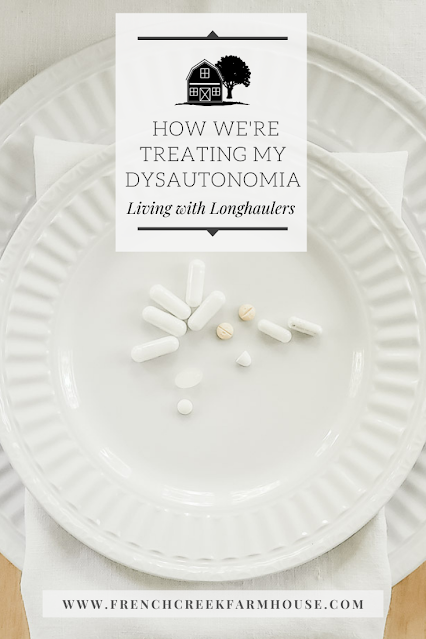
Disclosure: This is not a sponsored post, and I have received no compensation for sharing anything that follows. Some links within this blog may be affiliate
links, and I might earn a commission if you make a purchase through that link. This usually amounts to cents, not dollars, and helps to support the projects featured on this blog. I only recommend products from companies that I have found to be trustworthy. Read my full disclosure here.
Additionally, what follows is a glimpse into our family’s personal experience with dysautonomia. Nothing shared here should be interpreted or used as medical advice. Due to the intimate nature of sharing our experience, we will certainly be omitting some details that are private, so you are only reading the part of any given story that we have decided to share. Please do not base any of your decisions on our experiences. Always consult your doctor about your personal health issues.
THE BACK STORY
If you’ve missed previous posts where I’ve shared about how we got here, these links will help to catch you up.
Since I’m planning to share updates monthly for right now, I don’t want to bore anyone by repeating the whole back story each time. However, if you’re unfamiliar with our story, you’ll probably have some questions. The three biggest questions are:
- What is dysautonomia,
- how did I get it, and,
- how are we treating it?
You can read all of those details here.
You can see past posts about our COVID journey here:
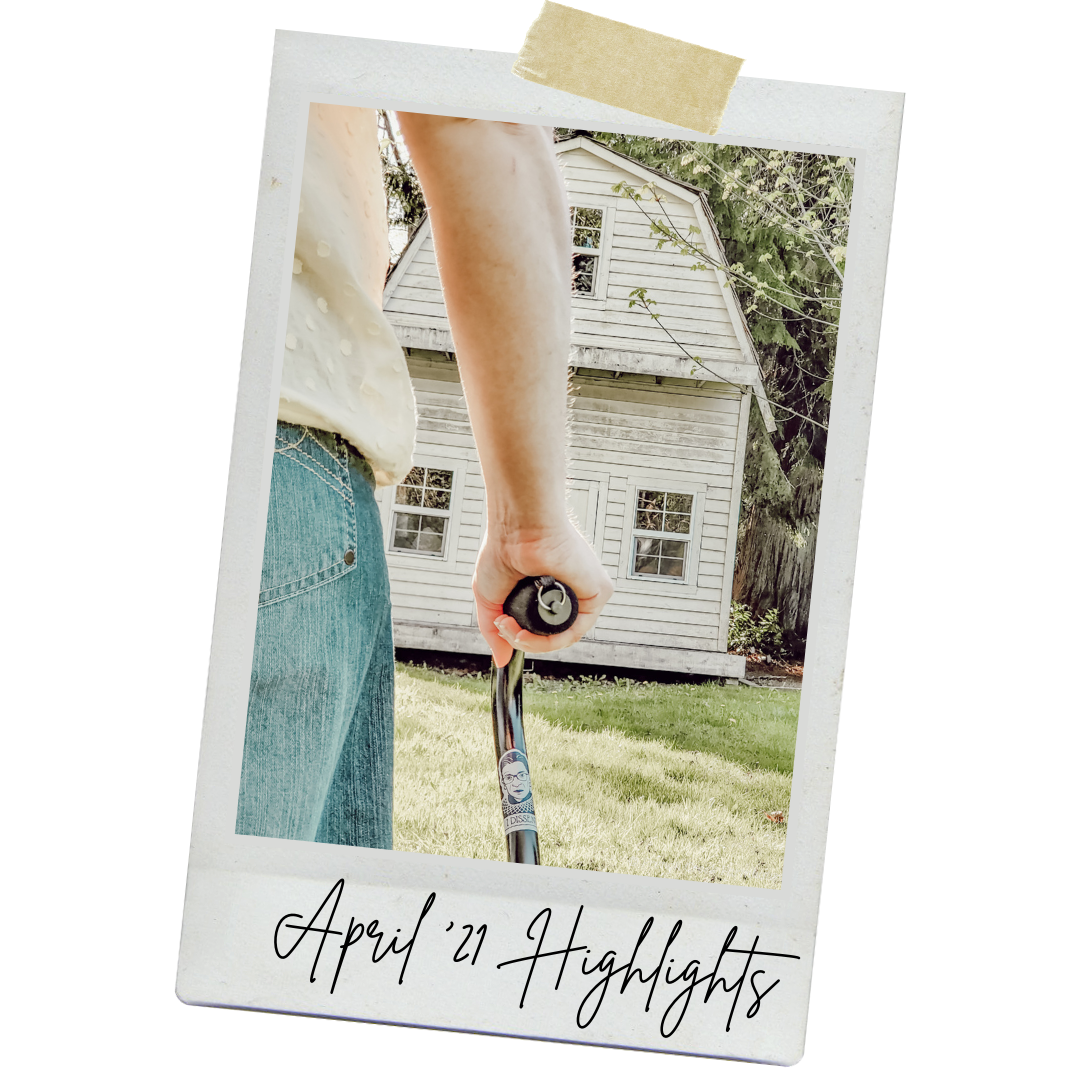 |
| April ’21 Highlights: I got the courage to hit ‘publish’ on my first health update post, and the support was so amazing. It makes SUCH a tremendous difference to have a caring community cheering us on as we go through this challenge. |
APRIL 2021 IMPROVEMENTS
April was the second month in the books without a trip to the hospital–that’s huge! Last month, we were so excited just to have had an entire calendar month without a trip, but we hardly wanted to think of it as a trend just yet. Now…two months?! In a row?! That feels like it could be an improvement, and we’re hopeful!
I will say, however, that I’m only cautiously optimistic right now. One thing that my doctor had told us is that, in his experience, he’s not sure how many patients actually experience “improvement” versus simply learning to live better with their symptoms.
That might be all that’s happening here. Considering where we are along this timeline, it might just be that we’re learning how to manage my symptoms better rather than actually improving.
For example, medication adjustments take a lot of trial and error. When we added a new medication back in December, my symptoms started to swing wildly. I would feel great one day, and then spend a week in horrible pain while we tried to find “the sweet spot” for dosing and timing.
After several months of that, it does feel like we we’ve hit that spot, which means that I’m experiencing fewer roller coaster rides with my symptoms…but the symptoms are all still there.
I suppose only time will tell.
And, in the spirit of transparency, there were no other improvements of note in April. I’m not discouraged by this, though. Not every month is going to be a milestone moment in this journey…sometimes “not getting worse” is just as good!
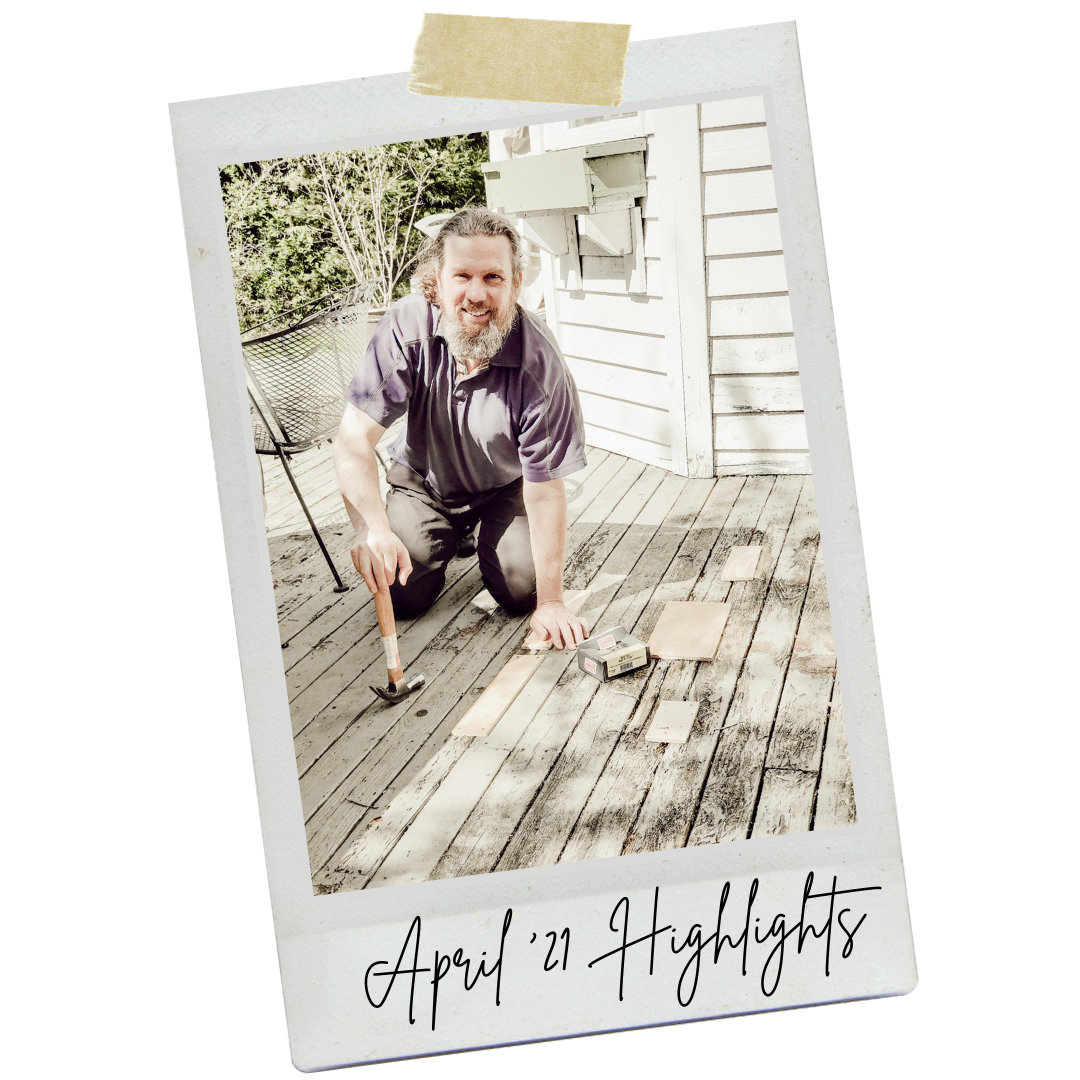 |
| April ’21 Highlights: We created our “patchwork deck” to get us through until the lumber prices come down a bit. Or, you know, we win the lottery. Whichever comes first. 😉 |
APRIL 2021 CHALLENGES
I had quite a number of tough days in April, and those aren’t just hard on my body, but also on my spirit. I leaned on the pharmacological treatments more heavily in April simply because I was so tired of feeling lousy.
Normally, I try to limit my reliance on prescriptions medications and use the plethora of dysautonomia management techniques that my doctor has recommended, but I had added some things to my plate that made that tough…like, preparing to host a group of blogging friends for a Spring Home Tour. I needed to be able to complete my project for that tour, and the only way I could make that happen last month was with the support of meds.
We also had to do a little work on our back deck. Originally, we’d planned to entirely replace our deck this year. It’s at least 30 years old, and while we’ve been replacing boards here and there to maintain it ever since we bought the house, it’s just time for it to be done. However, with the price of lumber going through the roof, the budget we’d set aside for that project isn’t even close to being able to cover it anymore.
Yet, after the winter storms, there were several hazardous spots that we worried could cause injuries if someone stepped through the boards. So, we decided to do some temporary patches to the spongy spots with some leftover plywood we had in the garage. It’s not pretty, but it will get us by for a little while until lumber prices come down a bit, or when we’re able to add to our savings for that project.
We’re calling it our “patchwork” deck! Haha!
So, that required two mornings of work (because the afternoons were too warm for my heart to handle). I was able to mostly stay seated on my garden cushion and just scoot around the deck to keep from dealing with too many symptoms, and I used meds heavily for those two days, as well.
This was a pretty small project, but I couldn’t do it by myself. Rob had to take over after I got the point where I couldn’t stand up without collapsing.
It felt nice to be able to contribute a little, but, I still paid for it, and spent about a week having to lay low after that. Even that small amount of effort just does such a number on my body.
I had significantly more chest pain this month, and it weighed heavily on my mind. I had one day when even the meds weren’t controlling the pain and keeping my heart rate in check, and that was a bit scary.
Every once in a while, I catch myself worrying about how much this condition might be shortening my life. I try to remind myself that worrying is not only not helping anything, but also could be actively making things worse. Instead, I try very hard to re-focus on what’s positive.
Finally, there was also one choking incident in April (down from two the month before). This is another one of the reasons why I still can’t be left alone, and Rob has to be my constant caregiver. Not an easy thing for either of us.
 |
| April ’21 Highlights: I finalized the oatmeal chocolate chip cookie recipe I’d been working on…free from all 8 of the top allergens! |
MY CURRENT SYMPTOMS
When I put this list together for last month’s update, it was the first time I’d ever seen all of my symptoms in list form. It was more than a bit overwhelming to see how long it was!
But, on the plus side, I can use it to keep track of when things improve (God willing!).
All of these symptoms are run of the mill for dysautonomia patients, so I’m certainly not special by any means, and there are patients who have it much worse than I do.
- Tachycardia
- Bradycardia (none in April!)
- Heart palpitations
- Chest pain
- Shortness of breath
- Hypovolemia (none in April!)
- Low blood pressure
- Dizziness/lightheadedness
- Fainting/near-fainting
- Tinnitus
- Tremors
- Difficulty walking
- Muscle/Joint/Bone pain
- Brain fog/memory problems/confusion
- Difficulty speaking
- Blurred vision
- Dry or teary eyes
- Migraine headaches
- Sleeping problems
- Extreme fatigue
- Difficulty regulating body temperature/Heat and cold intolerance
- Difficulty swallowing
- Nausea and/or abdominal pain
- Heartburn
- Vomiting
- GI distress
- General weakness
- Over-sensitivity to smell/distorted sense of smell
- Loss of ability to smell/taste (comes and goes unpredictably)
 |
| April ’21 Highlights: It was incredibly soul-filling to be able to work on creating our vintage spring tablescape. |
CURRENT TREATMENT APPROACHES
In April, we made no changes to the treatment approach of my dysautonomia. You can read about what we’re currently using/doing in this post.
As I mentioned up above, I did lean much more heavily on the pharmacological approach this month, for two reasons. First, I had a couple of things I needed to get done that I simply would not have been able to do at this time without medications–the blog tour I was getting ready to host, and the temporary patches we made to our deck.
Second, and maybe more importantly, feeling lousy was taking a pretty big toll on my spirit. The emotional ramifications of becoming disabled at the prime of your life when you were previously active and healthy is a serious matter.
A few people have asked me why I don’t just take all the meds, all the time. That’s a very reasonable question, and there are three parts to the answer.
- The research into dysautonomia has taught doctors some important things about how to treat patients, and each patient is unique. What they do know from those studies is that non-pharmacological approaches are tied to better health outcomes in the long run.Now, that said, there are some patients (like me) who start off completely bedridden. That means, those patients can’t even start doing those other treatment approaches without first taking meds…which is exactly how we started out. I mean, if your body can’t even handle sitting upright in bed, how are you supposed to do aerobic exercise? But we have worked hard to get to the point where I’m minimizing the number of medications I take, and I’m really trying not to rely on them (or add any new ones to the mix).
- The side effects of these medications are no joke.Depending on the day, I’m currently swallowing 10-16 pills per day. Some make me feel very sick, even if they do help control my heart rate. So, is it better to be upright and horribly ill, or to have to lay in bed to keep your heart rate at a reasonable level? The answer is: It depends.Some days, the side effects are worth it and necessary. At the same time, my body has to process all these pills, and that’s tough on the internal organs, as well. Do I want to tax my kidneys and liver trying to manage my heart? It’s a tough call. There isn’t a clear-cut easy answer, and we make the decision day-by-day.
- And that leads into the third part, which is that, quite often, taking meds creates a domino effect.One medication will cause side effects that require another medication. And then that medication causes another side effect that requires yet another medication. Before you know it, you’re taking meds to manage the effects of other meds, and it gets out of control. I’m already experiencing this with my current medications, and I’m trying hard not to let it increase.
The bottom line is that every patient is unique, every patient’s set of symptoms and circumstances is different, and there isn’t a one-size-fits-all approach to dysautonomia treatment. Each person has to make choices they can live with, knowing that there are both pros and cons to any choice they may make. It’s a very personal choice that each patient has to make with their doctor and loved ones.
 |
| April ’21 Highlights: This was the first season that I’ve done any real decorating around our home, and it brought me more joy than I can express with words! |
LOOKING AHEAD
As the weather is warming, it’s making me a little nervous about what’s to come. Last summer, my heart had a really tough time handling the heat. Here in the Pacific Northwest, homes don’t usually have air conditioning. We did, however, purchase a stand-alone unit for our bedroom, but locking myself away in one room of the house for the season is not ideal.


